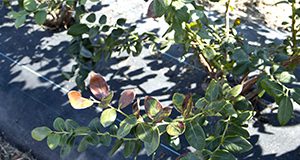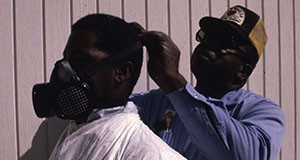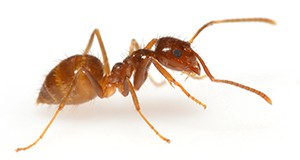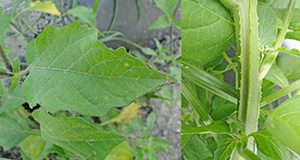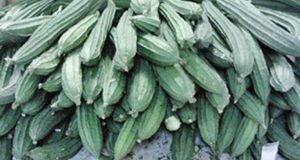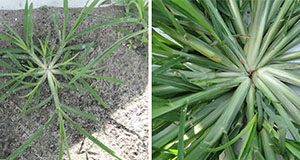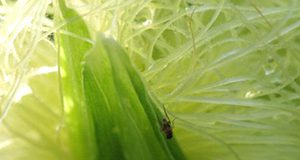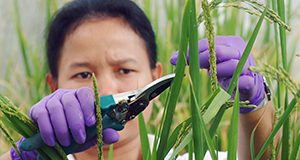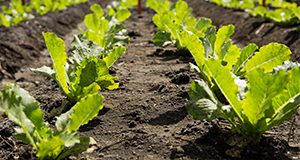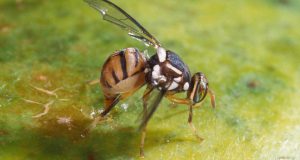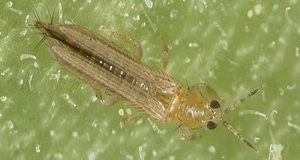Bacterial wilt is a newly discovered disease of blueberry in Florida. Plants with bacterial wilt will show signs of water stress such as wilting and marginal leaf burn. The disease was initially confirmed on three farms in Florida. This three-page fact sheet describes the symptoms, occurrence, and management of bacterial wilt in blueberry. Written by Philip F. Harmon, Carrie Harmon, and Dave Norman and published by the Plant Pathology Department.
http://edis.ifas.ufl.edu/pp332
Category: Crops
Worker Protection Standard: Notification and Hazard Communication
In 1992, the US Environmental Protection Agency (EPA) issued a comprehensive regulation called the Worker Protection Standard for Agricultural Pesticides (WPS). The EPA has made several changes to the WPS since it was fully implemented in 1995. On November 2, 2015, the EPA made significant changes to the rule’s requirements. Most of the revised provisions will become effective January 2, 2017 and there are four provisions that are delayed until January 2, 2018. This five-page fact sheet answers questions regarding changes made to the rules about notification and hazard communication. Written by Frederick M. Fishel and Tatiana Sanchez, and published by the Agronomy Department.
http://edis.ifas.ufl.edu/pi266
2016 Florida Blueberry Integrated Pest Management Guide
This 37-page fact sheet provides extensive information about integrated pest management for growing blueberry plants in Florida. Writteny by Jeffrey G. Williamson, Philip F. Harmon, Oscar E. Liburd, and Peter Dittmar and published by the Horticultural Sciences Department.
http://edis.ifas.ufl.edu/hs380
The Pecan Truffle (Tuber lyonii): A Gourmet Truffle Native to the Southeastern United States
A truffle is a round, knobby, or lobed mushroom fruiting body that forms below ground. The “pecan truffle” (Tuber lyonii) is an edible truffle species, native to eastern North America. This fungus lives in a mutually beneficial relationship with the roots of some trees, including species of oak, hazelnut, and hickory trees, as well as the cultivated pecan tree. This four-page fact sheet describes the pecan truffle, its economic and culinary significance, morphology, and phenology and distribution. Written by Arthur C. Grupe II, Timothy Brenneman, Gregory Bonito, and Matthew E. Smith and published by the Plant Pathology Department.
http://edis.ifas.ufl.edu/pp330
Integrated Pest Management (IPM) of the Tawny Crazy Ant, Nylanderia fulva (Mayr)
The tawny crazy ant infests buildings and greenhouses, attacks crops, domestic animals, and honeybee hives, displaces native ant species, and disrupts electrical equipment. This 8-page fact sheet describes how to identify the ant and monitor for infestations. It explains how to eliminate food sources and harborages and presents an integrated pest management plan and specific approaches to control this pest ant. (Note: the tawny crazy ant is a serious pest that multiplies quickly and can easily become an overwhelming problem. If you suspect you have tawny crazy ants, the best approach is to call a licensed pest-control professional for help). Revised by Faith Oi, Dawn Calibeo, John Paige III, and Michael Bentley and published by the UF Department of Entomology and Nematology.
http://edis.ifas.ufl.edu/in889
Biology and Management of American Black Nightshade (Solanum americanum P. Mill.) in Tomato, Pepper, Cucurbit, and Strawberry
This three-page fact sheet describes the biology and management of American black nightshade, explaining how to control for it in tomato and pepper, cucurbits, and strawberry. Written by Nathan S. Boyd, Shawn Steed, Chris Marble, and Andrew MacRae and published by the Horticultural Sciences Department.
http://edis.ifas.ufl.edu/hs1176
Cost Estimates of Establishing and Producing Thai Guavas in Florida, 2014
The white Thai guava variety, which is very popular in the Asian market, is beginning to expand into mainstream markets. It has quick, high yields, is easily propagated and is tolerant to moisture stress and soil salinity. But even though it offers favorable returns, there has been little information about the cost of production. This 7-page fact sheet identifies inputs, costs, and yields considered to be typical of a well-managed five-acre Thai guava orchard in south Florida. Written by Stella Garcia, Edward A. Evans, and Jonathan Crane and published by the UF Department of Food and Resource Economics, August 2016.
http://edis.ifas.ufl.edu/fe998
New Featured Creatures for October 2016
- A Bark Beetle Hypothenemus eruditus Westwood, 1836
http://edis.ifas.ufl.edu/in1147 - Fourlined Plant Bug Poecilocapsus lineatus (Fabricius)
http://edis.ifas.ufl.edu/in1151 - Insidious Flower Bug, Minute Pirate Bug Orius insidiosus Say
http://edis.ifas.ufl.edu/in1148 - Longtailed Mealybug Pseudococcus longispinus (Targioni Tozzetti)
http://edis.ifas.ufl.edu/in1149 - Tuliptree Scale Toumeyella liriodendra (Gmelin)
http://edis.ifas.ufl.edu/in1150
Luffa: an Asian Vegetable Emerging in Florida
Luffa is the genus name of several tropical and subtropical plants in the cucumber family. Alternatively spelled “Loofa” or “Loofah,” the name is derived from the plant’s use as a material for sponges and dish cloths for bathing and cleaning dishes. This six page fact sheet describes the two types of Luffa, how to cultivate them, and what they can be used for. Written by Yucong Xie, Guodong Liu, Yuncong Li, and Kati Migliaccio and published by the Horticultural Sciences Department.
http://edis.ifas.ufl.edu/hs1285
Sequential Sampling for Wireworms (Coleoptera: Elateridae) at Sugarcane Planting
In the Everglades Agricultural Area of Florida, where sugarcane is planted on around 410,000 acres annually, wireworms are the most economically important insect pests of newly planted sugarcane. This 3-page fact sheet written by Matthew T. VanWeelden and Ron Cherry and published by the Department of Entomology and Nematology provides a step-by-step plan to determine whether an application of soil insecticide may be needed to control wireworms. This publication is also a part of the Florida Sugarcane Handbook, an electronic publication of the Agronomy Department.
http://edis.ifas.ufl.edu/in1143
Biology and Management of Goosegrass (Eleusine indica (L.) Gaertn.) in Tomatoes, Peppers, Cucurbits, and Strawberries
This four-page fact sheet gives a brief description of the biology and management of goosegrass, a common annual turf and horticultural weed found throughout Florida that grows well in compact, wet soils and superficially resembles crabgrasses. Written by Nathan S. Boyd, Kiran Fnu, Chris Marble, Shawn Steed, and Andrew W. MacRae and published by the Horticultural Sciences Department.
http://edis.ifas.ufl.edu/hs1178
Pest Identification Guides, August 2016
Created to help growers and crop consultants, private homeowners, Master Gardeners, and the general public identify common arthropod pests and the damage they inflict, each field guide provides photos of the important life stages and crop damage associated with arthropod pests. The text highlights key general morphology and biology, distribution, and natural enemies. Written by Jeffrey Cluever and Hugh Smith, and published by the UF Department of Entomology and Nematology.
The following have been added to the existing series, http://edis.ifas.ufl.edu/topic_series_pest_identification_guides
Cob Flies, Megaselia spp. (Diptera: Phoridae), in Sweet Corn
Phorid flies (Diptera), also known as humpback flies or scuttle flies for their appearance and behavior, are an extremely diverse group of flies that are saprophagous (feed on decaying organic matter), parasitic, or phytophagous (feed on plants). Within the Phoridae family, the genus Megaselia is also extremely diverse, with more than 1400 described species, many very similar in appearance. The name “cob fly” was given to a Megaselia spp. that attacked corn in Texas. This 5-page fact sheet written by David Owens, Gregg S. Nuessly, Robert Beiriger, and Nicholas Larsen and published by the Department of Entomology and Nematology describes the distribution of this pest, ways to distinguish it from other similar corn ear pests, its life cycle, the damage it causes, and some strategies for management.
http://edis.ifas.ufl.edu/in1144
Trends in Rice Production and Varieties in the Everglades Agricultural Area
Rice production in the Everglades Agriculture Area (EAA) of Florida dates back nearly seven decades. For a brief period in the 1950s about 2,000 acres of rice was grown in the EAA. Rice was reintroduced in the EAA in 1977 after it was demonstrated that rice could be successfully incorporated into the sugarcane production cycle during the fallow period. This three-page fact sheet provides a history of rice production in Florida and information about rice varieties grown in Florida. Written by Jehangir H. Bhadha, Luigi Trotta, and Matthew VanWeelden and published by the Soil and Water Sciences Department.
http://edis.ifas.ufl.edu/ss653
Organic Management of Vegetable Diseases, Part II: Foliar Pathogens
The successful management of both soilborne and foliar diseases requires a multifaceted program, taking into consideration variety selection, cultural methods, biologicals, and chemical applications approved by the Organic Materials Review Institute (OMRI) and certified organic under the United States Department of Agriculture (USDA) National Organic Program (NOP). This review emphasizes the management of foliar disease and serves as a guide to assist growers in selecting strategies to manage disease in a sustainable system. Written by Gary Vallad and published by the Department of Plant Pathology.
http://edis.ifas.ufl.edu/pp170
Summer Squash Production in Miami-Dade County, Florida
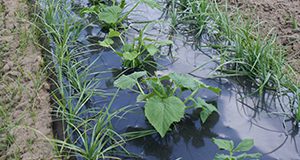
Summer squash is an important vegetable crop in Miami-Dade County. It is grown annually on about 6,000 acres and sold nationwide during the winter in the fresh market. This 16-page fact sheet describes the varieties of summer squash, land preparation and transplanting, what fertilizer to use, irrigation and freeze protection, disease management, insect management, weed management, harvest, and crop rotation. Written by D. Seal, S. Zhang, M. Ozores-Hampton, P. Dittmar, Y. Li, W. Klassen, Q. Wang, and T. Olczyk and published by the Horticultural Sciences Department.
http://edis.ifas.ufl.edu/tr012
Estimated Costs and Regional Economic Impacts of the Oriental Fruit Fly (Bactrocera dorsalis) Outbreak in Miami-Dade County, Florida
Oriental fruit flies, very destructive pests of fruits, were first detected in the Redland area of Miami-Dade County on August 26, 2015, and as of January 2016, 165 flies had been captured. This triggered an eradication program and establishment of a quarantine area composed of agricultural operations and nonagricultural properties, such as residential and commercial areas. As part of the effort to eradicate the fruit fly, growers and packers in the quarantine area are required to sign a compliance agreement that outlines the procedures necessary for harvesting, handling, and postharvest processing of agricultural products that may serve as hosts for any life cycle of the fruit fly. This 12-page fact sheet written by Sergio Alvarez, Edward A. Evans, and Alan W. Hodges and published by the UF Food and Resource Economics Department provides estimates of the direct and indirect losses to Florida’s agriculture and related sectors as a result of the outbreak and ensuing quarantine and eradication programs.
http://edis.ifas.ufl.edu/fe988
Pest Identification Guide: Western Flower Thrips Frankliniella occidentalis (Pergande)
Western flower thrips transmits the carmovirus Pelargonium flower break virus (PFBV), the ilarvirus Tobacco streak virus (TSV), and the tospoviruses Chrysanthemum stem necrosis virus (CSNV), Groundnut ringspot virus (GRSV), Impatiens necrotic spot virus (INSV), Tomato chlorotic spot virus (TCSV), and Tomato spotted wilt virus (TSWV). This species is primarily a flower feeder, so most damage would be expected on the flower or fruit. Learn to identify the western flower thrips with this two-page illustrated guide written by Jeffrey D. Cluever and Hugh A. Smith and published by the Department of Entomology and Nematology.
http://edis.ifas.ufl.edu/in1127
Carinata, the Jet Fuel Cover Crop: 2016 Production Recommendations for the Southeastern United States
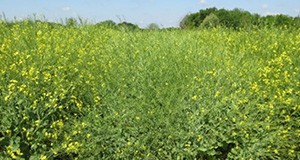
Carinata has been grown commercially for several years on the Canadian prairie and more recently in the US northern plains as a summer crop. For the past four years, UF has been conducting research to evaluate various management practices that allow incorporation of carinata into current cropping systems as a winter crop with minimal modification to existing infrastructure in the southeastern US. This 8-page fact sheet is a major revision that discusses carinata characteristics, biology, nutrient management, tillage, variety selection, planting dates, seeding depth, seeding rate, row spacing, weed management, disease management, insect management, harvest management, economics, and crop insurance. Written by Ramdeo Seepaul, Christine M. Bliss, David L. Wright, Jim J. Marois, Ramon G. Leon, Nicholas Dufault, Sheeja George, and Steve M. Olson, and published by the UF Agronomy Department, December 2014. Revised October 2015.
http://edis.ifas.ufl.edu/ag389
Guide to Olive Tree Nutrition in Florida
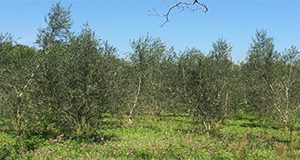 A burgeoning olive industry already exists in the southeastern United States, but research and Extension information regarding olive fertilization recommendations in Florida is limited. While there are data and recommendations for olive from the University of California, the University of Georgia (UGA), and other institutions around the world, there are no data from which we can derive Florida-specific recommendations. This 6-page fact sheet uses many of the existing recommendations for mature, high-density, and traditional grove spacing as guidelines until data specific to Florida production are generated. It discusses leaf tissue sampling procedures, leaf tissue sufficiency ranges, nitrogen fertility, phosphorus and potassium fertility, boron, concerns for olive production in Florida, and other resources for olive production in the state. Written by Michael J. Mulvaney, Rao Mylavarapu, Peter C. Andersen, Mack Thetford, and Jennifer L. Gillett-Kaufman, and published by the UF Agronomy Department, May 2016.
A burgeoning olive industry already exists in the southeastern United States, but research and Extension information regarding olive fertilization recommendations in Florida is limited. While there are data and recommendations for olive from the University of California, the University of Georgia (UGA), and other institutions around the world, there are no data from which we can derive Florida-specific recommendations. This 6-page fact sheet uses many of the existing recommendations for mature, high-density, and traditional grove spacing as guidelines until data specific to Florida production are generated. It discusses leaf tissue sampling procedures, leaf tissue sufficiency ranges, nitrogen fertility, phosphorus and potassium fertility, boron, concerns for olive production in Florida, and other resources for olive production in the state. Written by Michael J. Mulvaney, Rao Mylavarapu, Peter C. Andersen, Mack Thetford, and Jennifer L. Gillett-Kaufman, and published by the UF Agronomy Department, May 2016.
http://edis.ifas.ufl.edu/ag405
